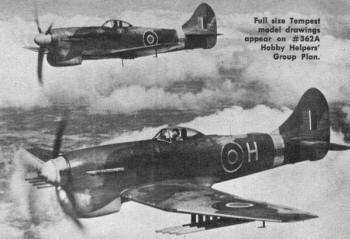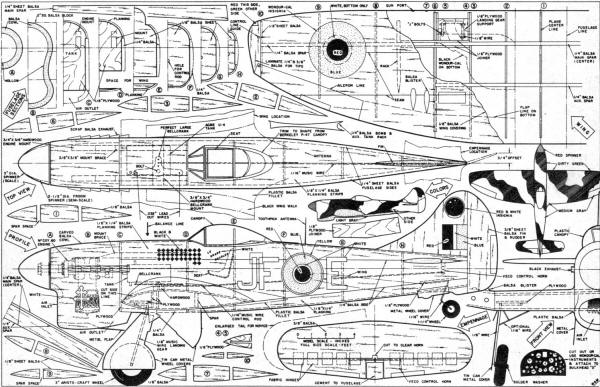|
Hawker
Hurricanes were the first line of defense for London against the onslaught
of jet-powered German V-1 Buzz Bombs. Tempests were used as interceptors,
fighter-bombers, escorts, for ground-attack duties against tanks and stationary
targets. The plans are for a control line model scaled at one inch to the
foot, which results in a 42" wingspan. Power is a McCoy .60, which would
make for a very over-powered model. Ample room in the nose section easily
accommodates a large powerplant in the model as it did in the full-size
craft; in fact, the 24-cylinder Napier "Sabre" gave the Tempest a top cruise
speed of 435 mph! This is a companion article to "Clo
Clo" - Terror in a Tempest. Hawker Tempest
 During
the latter part of World War Two, French Ace Pierre Clostermann flew the
rugged Hawker Tempest V which made its appearance at the front in April
1944. A development of the earlier, and not too successful Typhoon, the
Tempest was a vastly superior airplane. Designed by Sidney Camm of Hurricane
fame, the "V" was the only variation to be employed operationally during
the war. During
the latter part of World War Two, French Ace Pierre Clostermann flew the
rugged Hawker Tempest V which made its appearance at the front in April
1944. A development of the earlier, and not too successful Typhoon, the
Tempest was a vastly superior airplane. Designed by Sidney Camm of Hurricane
fame, the "V" was the only variation to be employed operationally during
the war. This Hawker, the fastest medium-altitude fighter in the
Royal Air Force, had a speed of 435-mph hour at 17,000 feet. This coupled
with the four 20-millimeter wing cannon made the Tempest the mainstay of
England's defense against Germany's V-1 jet powered "buzz" bombs. This type
aircraft accounted for more than one third of the 1,800 "buzz" bombs destroyed
during the summer of 1944. In addition to its cannon; two 1,000-lb
bombs or eight rockets could be carried as offensive armament. Powering
this large 13,500-lb plane was Napier's unique "Sabre" 24-cylinder, "H"
type, horizontal liquid cooled, sleeve valve design which developed 2,400-hp.
Range for the "V", 820 miles could be extended via two drop tanks to 1,300
miles. Altitude of 10,000 feet could be reached in 2.7 minutes.
Versatile Tempests were employed as interceptors, fighter-bombers, escorts,
for ground-attack duties against tanks and stationary targets. Carbon-monoxide
fumes which seeped into the cockpit dictated the use of oxygen at all times.
Our plans are scaled one-inch-to-the-foot to produce a model for
powering with an engine from .29 to 60 cubic inch displacement.
Construction begins as follows: Cut fuselage sides from 1/4" sheet balsa,
bulkheads from specified material. Bevel inboard surface of sides at rear
(shown in top view), cement sides together at this point ... hold with pins
or clamps until dry. Cement bulkheads in place between two sides, set aside
to dry. Cut engine mounts, slip through bulkheads, cement well. The brace
is required only if engine mount is cut away as shown for fuel tank and
a .45 or larger engine. Apply several coats of cement around engine mount
attachment. Cut sheet balsa elevator and stabilizer. Join elevator
halves by control horn or hardwood spar. Hinge elevator assembly to stabilizer,
cement stab into fuselage slot. It is important to cut away portion of inner
surface of each fuselage side to insure adequate freedom of movement of
control horn. Commercial bellcrank bolts to piece of engine mount
material which is then well cemented to both fuselage sides. Cut control
rod to length and slide through small holes in bulkheads. Using long nose
pliers bend both ends of wire to fit through horn and bellcrank. Slip bent
respective holes, solder washers to ends. The bulkhead small holes act as
guides to keep control rod from bending when "up" elevator is applied.
Any standard fuel tank should fit - this item is installed. It may
be necessary to trim away some of the engine mount to accommodate a tank
of sufficient capacity for your engine. Secure tank with straps or wedges,
plus balsa braces and ample cement. Add filling, vent, and fuel line plastic
tubing. Tape its open ends to keep tank clean. Additional construction
instructions are on Hobby Helpers' plans. The author expresses sincere
appreciation to Mr. A. E. Ferko for his kind assistance which made this
article possible.
 Hawker Hurricane Plans
Notice:
The AMA Plans Service offers a
full-size version of many of the plans show here at a very reasonable cost. They
will scale the plans any size for you. It is always best to buy printed plans because
my scanner versions often have distortions that can cause parts to fit poorly. Purchasing
plans also help to support the operation of the
Academy of Model Aeronautics - the #1
advocate for model aviation throughout the world. If the AMA no longer has this
plan on file, I will be glad to send you my higher resolution version.
Try my Scale Calculator for
Model Airplane Plans.
Posted February 20, 2022
(updated from original post on 11/9/2013)
|